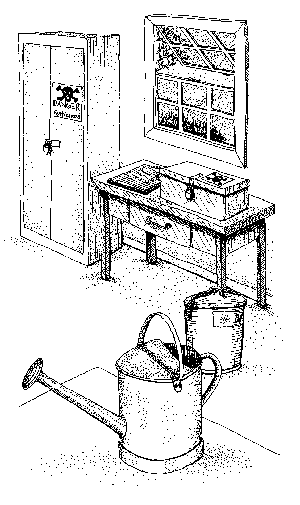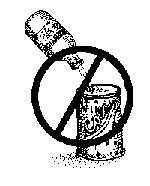 Storage Tips
Storage Tips
 1) Consult the
label for specific storage requirements.
1) Consult the
label for specific storage requirements.
 2) Design a
pesticide storage area.
2) Design a
pesticide storage area.
 3) Store pesticides
safely.
3) Store pesticides
safely.
Proper storage of pesticides, both synthetic and botanical, in and around the
home is important for many reasons, including protection of human health,
preservation of the environment, and maintenance of chemical effectiveness. One
way to minimize storage problems is through good planning.
Buy only the amount of pesticide that you need for a specific job or for the
current growing season. The smaller volume containers, even if more expensive
ounce for ounce, may in fact be the "best buy" in the long run, eliminating
waste and the need for storage space. If you need to store pesticides on your
property, follow these guidelines - for safety's sake!
Return to Table of Contents

Always read the pesticide label for specific storage requirements. The
chemical and the container in which it is purchased must be maintained in good
condition. This is necessary to ensure that the material remains useful, and to
avoid environmental or human health hazards.
Return to Table of Contents
Design or designate a pesticide storage area that meets the following
requirements:

-
easy to lock
-
well-ventilated
-
properly lighted when in use
-
dry - protected both from flooding and high humidity
-
protected from extreme heat and freezing
-
spacious enough to allow for separation of herbicides, fungicides,
insecticides, and fertilizers if all these types of materials are to be stored
-
enclosed in such a manner that leaks and/or spills may be contained and
cleaned without compromising the soil and water quality in the vicinity
The storage area must be designed to keep out unwanted visitors, especially
children and animals! Good lighting and ventilation are important to protect the
health of anyone using the storage area. Proper ventilation can also prevent
chemicals from affecting other materials in storage. It is essential to store
pesticides where their fumes cannot invade areas used by people or pets. Group
stored chemicals by type as a precaution against contamination.
Dampness is a serious problem, as it reduces the shelf life of many chemicals
and causes metal and paper containers to decompose. It is imperative that
storage areas be designed so that there is no danger of chemicals being washed
into our water by flooding or by accidental spills into water drains.
Temperature extremes can cause physical or chemical changes to pesticide
products. Such changes may make the product ineffective and/or cause plant
injury. Heat makes chemicals more volatile and unstable. Freezing can cause some
types of containers to break open. If specific temperature ranges are required
for proper storage, they will be printed on the product label.
Finally, the site must be designed to contain, or stop the further spread of,
any spills and/or leaks.
Return to Table of Contents
Use approved management techniques for storing pesticides safely:
-
Locate your storage area where clean-up materials (absorbents, water) will
be near at hand.
-
Keep pesticides in their original containers. A legible product label must
be attached to the chemical container.
-
Do not store pesticides with or near food, medicine, or cleaning supplies.
-
Do not store pesticides with or near seed or animal feed.
-
Do not store flammable materials with pesticides.
-
Organize the materials in storage so they are accessible and visible.
-
Place opened containers in clear plastic bags or see-through plastic ware.
This will allow for easy identification of products while containing leaks and
helping to avoid accidental spills.
-
Mark all containers with the date of purchase. Keep a written inventory of
materials on hand, and use older chemicals first. A storage inventory helps in
planning purchases next season. Useful records may include product name,
active ingredient, date of purchase, record of use, and date and volume
stored.
-
Routinely inspect your storage area. Check containers for damage or leaks.
Dispose of unwanted or outdated material according to the label
recommendations.
Never transfer excess pesticide or fertilizer to an empty food container.
A child or non-reader may be poisoned accidentally!
Return to Table of Contents
![]() Gardeners' Corner
Kids'
Garden
Sustainable Garden
Contact Us
Gardeners' Corner
Kids'
Garden
Sustainable Garden
Contact Us![]()





